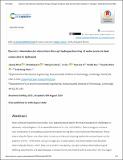| dc.contributor.author | Zhou, Jiawei | |
| dc.contributor.author | Lin, Shaoting | |
| dc.contributor.author | Zeng, Hongxia | |
| dc.contributor.author | Liu, Ji | |
| dc.contributor.author | Li, Buxuan | |
| dc.contributor.author | Xu, Yanfei | |
| dc.contributor.author | Zhao, Xuanhe | |
| dc.contributor.author | Chen, Gang | |
| dc.date.accessioned | 2020-09-04T15:49:42Z | |
| dc.date.available | 2020-09-04T15:49:42Z | |
| dc.date.issued | 2020-08 | |
| dc.date.submitted | 2020-05 | |
| dc.identifier.issn | 2051-6347 | |
| dc.identifier.issn | 2051-6355 | |
| dc.identifier.uri | https://hdl.handle.net/1721.1/127182 | |
| dc.description.abstract | Heat-conducting polymers provide a new opportunity to tackle thermal management challenges in advanced technologies such as wearable electronics and soft robotics. One strategy to enhance heat conduction in amorphous polymers has been tuning their intermolecular interactions. These intermolecular forces are often static in nature as the participating molecules are anchored on the polymer chains. In this work, using hydrogel as a model system, we demonstrate how dynamic intermolecular forces, which break and re-form constantly, can also enhance thermal transport. Utilizing calorimetric and spectroscopic measurements, we show that this arises from the hydrogen bonds formed between water and nearby polymer chains, which enhances the inter-chain heat transfer efficiency. This mechanism may potentially allow the design of heat-conducting polymers with self-healing or adaptability functionalities. | en_US |
| dc.description.sponsorship | Department of Energy (Award DE-FG02-02ER45977) | en_US |
| dc.publisher | Royal Society of Chemistry (RSC) | en_US |
| dc.relation.isversionof | http://dx.doi.org/10.1039/d0mh00735h | en_US |
| dc.rights | Creative Commons Attribution 4.0 International license | en_US |
| dc.rights.uri | https://creativecommons.org/licenses/by/4.0/ | en_US |
| dc.source | Royal Society of Chemistry (RSC) | en_US |
| dc.title | Dynamic intermolecular interactions through hydrogen bonding of water promote heat conduction in hydrogels | en_US |
| dc.type | Article | en_US |
| dc.identifier.citation | Zhou, Jiawei et al. "Dynamic intermolecular interactions through hydrogen bonding of water promote heat conduction in hydrogels." Materials Horizon (August 2020): dx.doi.org/10.1039/d0mh00735h © 2020 The Royal Society of Chemistry | en_US |
| dc.contributor.department | Massachusetts Institute of Technology. Department of Civil and Environmental Engineering | en_US |
| dc.contributor.department | Massachusetts Institute of Technology. Department of Mechanical Engineering | en_US |
| dc.contributor.approver | Xu, Yanfei | en_US |
| dc.relation.journal | Materials Horizon | en_US |
| dc.eprint.version | Final published version | en_US |
| dc.type.uri | http://purl.org/eprint/type/JournalArticle | en_US |
| eprint.status | http://purl.org/eprint/status/PeerReviewed | en_US |
| dspace.date.submission | 2020-08-31T18:35:30Z | |
| mit.license | PUBLISHER_CC | |
| mit.metadata.status | Complete | |

